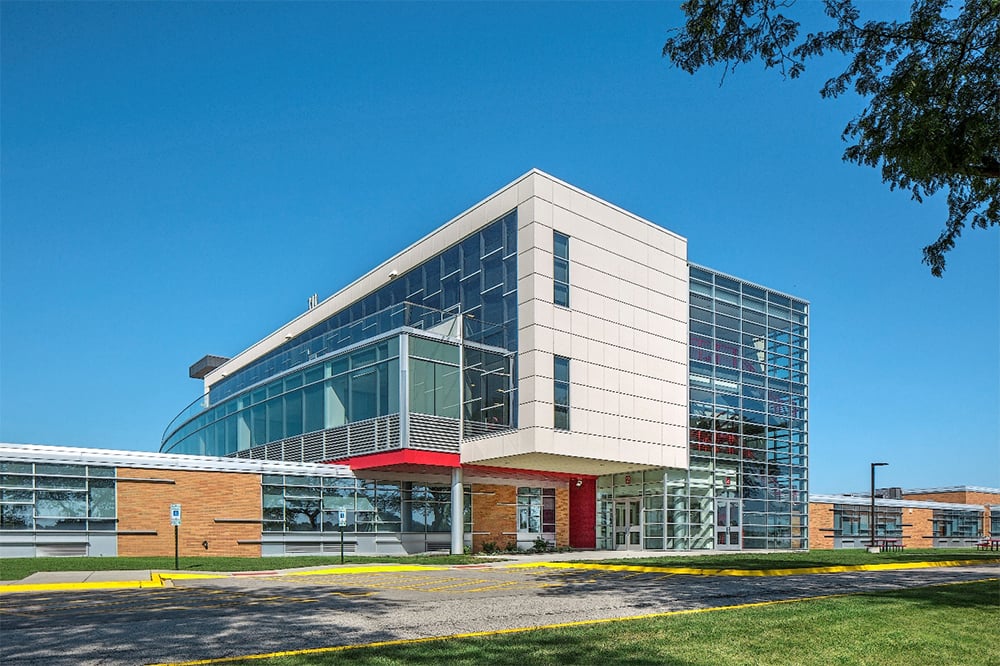With 49 recorded school shootings in 2018 and 2019, according to Education Week, and another 8 in 2020, safety in schools remains a top priority issue in the U.S.
Though the process of developing updated building codes and standards to better fortify facilities against shooter attacks is ongoing, at this time, no specific codes have been established.
That said, architects and glass fabricators should be aware that a number of codes and standards and initiatives related to designing with glass are underway with the goal of providing added guidance to school administrators and school building designers. Further, there are multiple design strategies and safety glass products that architects and fabricators can suggest if asked by a glazing contractor or local school district for recommendations about making educational facilities safer.

Standards in the Works
NFPA (National Fire Protection Safety Association) 3000 is the Standard for an Active Shooter/Hostile Event Response (ASHER) Program. The standard addresses issues such as identifying hazards and assessing vulnerability to planning, resource management, incident management at a command level, competencies for first responders, and recovery. While the document doesn’t provide specific how-to information, it is intended to educate first responders to help them develop their own local standard operating procedures.
ASTM Standard on Mitigation of Armed Aggressors in Educational Institutions is under development to “describe risk and threat analysis, design, specification, selection and application of building plans and systems to minimize the impact of armed aggressors in educational institutions.”
The intent of the standard is to provide best practices for hardening school systems. On the topic of glazing, the group is currently evaluating ASTM E2395 Standard Specification for Voluntary Security Performance of Window and Door Assemblies with Glazing Impact as it relates to school safety.
ICC International Code Committee’s Ad Hoc Committee on Building Safety. This group is currently evaluating building and fire-code requirements as they relate to developing the necessary balance between building security and fire safety considerations. The intent is to comprehensively explore and assess building safety and security.
The group of experts in the committee includes building owners and facility managers, individuals from the education sector and security fields, code officials, engineers, architects, standards developing organizations such as the National Fire Protection Association, and the federal government.
Federal Emergency Management Agency (FEMA) 428 - Primer to Design Safe School Projects in Case of Terrorist Attacks and School Shootings. FEMA 428 is recommended as a design guide for architects, glass fabricators and school districts.
National Glass Association’s Technical Paper FB43-14 provides guidance on security glazing. Additionally, NGA’s Fabricating Committee provides technical resources on fire-rated, protective, laminated and tempered glazing, and the NGA’s School Security Glazing task group is actively working to develop additional resources.
3 Ways Glass Can Promote School Safety
When working with school districts to upgrade their facilities’ level of physical protection against attacks, the following are recommended strategies:
Blast-resistant laminated glass. Glass shards have been identified as the most significant source of injury in shooting/bomb incidents, so investing in blast-resistant glass is an important strategy.
Delaying assailant entry. Laminated glass, laminated insulated glass units (IGUs) and multi-ply laminated glass are all capable of delaying the entry of an intruder by varying degrees. This affords first responders extra time to arrive on the scene, and the school is granted the opportunity to lock down.
Daylighting. Without dependency on electricity, daylit interiors offer precious light and wayfinding if an electrical loss is associated with an attack on a school. Daylit spaces enhance the school’s ability to transfer students and staff to a safe, secured location, and, because it enables staff and students to see, it helps maintain calm in emergency situations.
Five Glass Types for Safety Applications
In advising project teams and schools on the different glass types for safety applications, architects and glass fabricators can recommend the five listed below:
Single Safety Tempered Glass Lite. Four times stronger than regular annealed glass, monolithic safety breaks into smaller pieces when impacted, posing less danger for injury. It is less robust than other options and is therefore best suited for areas not prone to forced entry such as windows on upper floors.
Single Tempered Lite with Film/Plastic. This glass type also will break into smaller pieces when fractured, but the added layer of infill or plastic works to slow down forced entry or blasts. That makes it ideal for forced-entry, blast and safety settings, in addition to fire-rated and daylighting applications.
Laminated glass. In addition to fire resistance and daylighting, laminated glass offers good acoustics. as it mitigates sound.
Laminated insulating glass units (IGU). When incorporated into an IGU, laminated glass offers enhanced thermal protection during an emergency as a supplement to its primary function, which is to make buildings more energy efficient.
Multiple ply laminated glass. Capable of withstanding extreme conditions such as forced entry, blasts, ballistics, hurricanes and tornadoes, this glass type offers the benefits of acoustics, fire resistance and daylighting as well.
Ideally, the need to know and share this information should be rare for architects and fabricators; nevertheless, it can be helpful to understand as the next era of safer, post-COVID school design begins.
For any glass questions, please contact Vitro Glass or call 1-855-VTRO-GLS (1-855-887-6457).
Have a project? Request samples and evaluate your options.
Visit the Vitro Architectural Glass Sample & Fulfillment Center.
Updated on July 22, 2021




